Another Private Tour today, this time down in the Broads. The target today was specifically to find some of the unusual species we are fortunate to have here. Quality not quantity was the order of the day. It was a glorious day to be out – after the early mist burnt off, it was beautifully sunny at times in the morning.
We met at the NWT reserve at Hickling Broad. We did not have time to explore the whole reserve today, but it did seem like it might be worth a quick look out on the grazing meadows. Common Crane was a particular target species for the day. Our luck was in – we had not gone very far when we spotted a family of Cranes out on the grass, two adults and a fully grown juvenile from last summer. What a start!
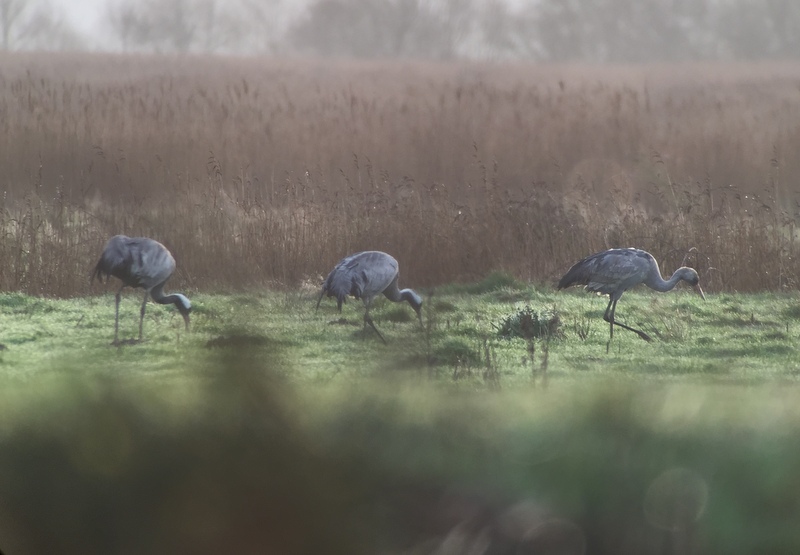 Common Crane – two adults with their 2015 juvenile (to the right)
Common Crane – two adults with their 2015 juvenile (to the right)
We watched the Cranes for some time, walking slowly around the field and picking down at the grass looking for food. The juvenile was obvious – lacking the adults’ black and white striped head and neck. At times, the adults stood and preened while the youngster carried on feeding.
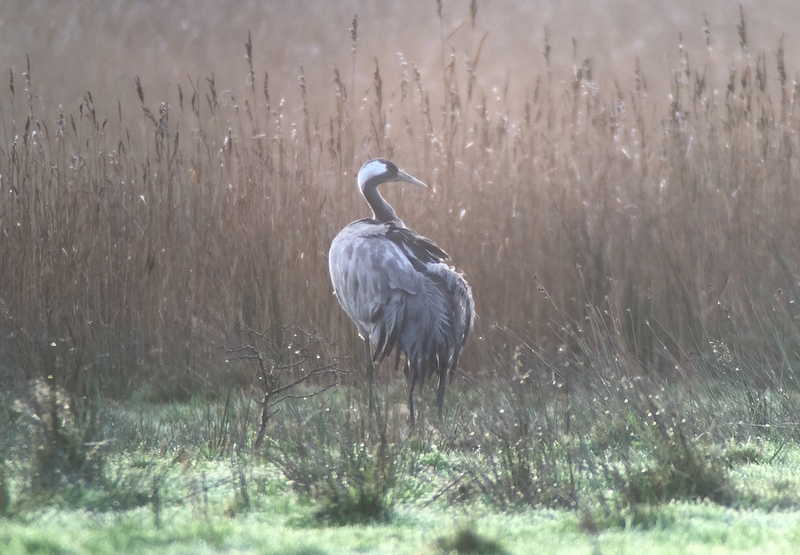 Common Crane – one of the adults, preening
Common Crane – one of the adults, preening
Eventually something seemed to spook them and they started bugling, before taking off and flying off across the reserve. We turned to head back and a sharp call caught our attention. On one of the gateposts by the ditch across the marshes was a Kingfisher. It sat for a while as we had a quick look at it, before flying off quickly across the water away from us.
We were not intending to go looking for the swans today – they were not on the target list for the day – but as they were visible from the road as we drove past it would have been churlish not to just pull off for a quick look. In the group nearest to us, we could see 20+ Whooper Swans and a smaller number of Bewick’s Swans. The latter were noticeably smaller and the yellow on their bills was squared off rather than extending down the bill in a point as it did on the Whoopers.
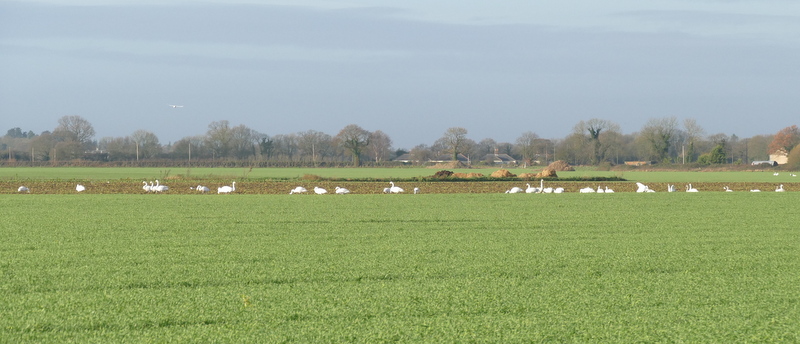 Whooper & Bewick’s Swans – feeding in the fields at Ludham today
Whooper & Bewick’s Swans – feeding in the fields at Ludham today
We could see more swans further over in another field beyond, making about 60 in total. There was also a small group of Golden Plover in the same field. A couple of Skylarks flew overhead calling in the sunshine.
 Whooper Swans – with the yellow extending down the bill into a point
Whooper Swans – with the yellow extending down the bill into a point
A Rough-legged Buzzard has been seen at Burgh Castle for the last few days and the Lesser Yellowlegs was reported there this morning. The latter, a rare wader from North America related to a Redshank, has been hanging around Breydon Water for a few weeks now, but has been very mobile and hard to see. Still, with the target to find some scarce birds, this seemed like a good place to try next.
Unfortunately, when we arrived on site the Lesser Yellowlegs was nowhere to be found. There were lots of Common Redshank and a careful scan of the banks of the river channel revealed a single Spotted Redshank as well. In winter plumage now, it stood out with its silvery grey upperparts, bright white underparts and longer needle-fine bill. Out on the mud, there were also several Avocet, Black-tailed Godwit and Dunlin. We could hear Bearded Tits calling from the reeds behind us.
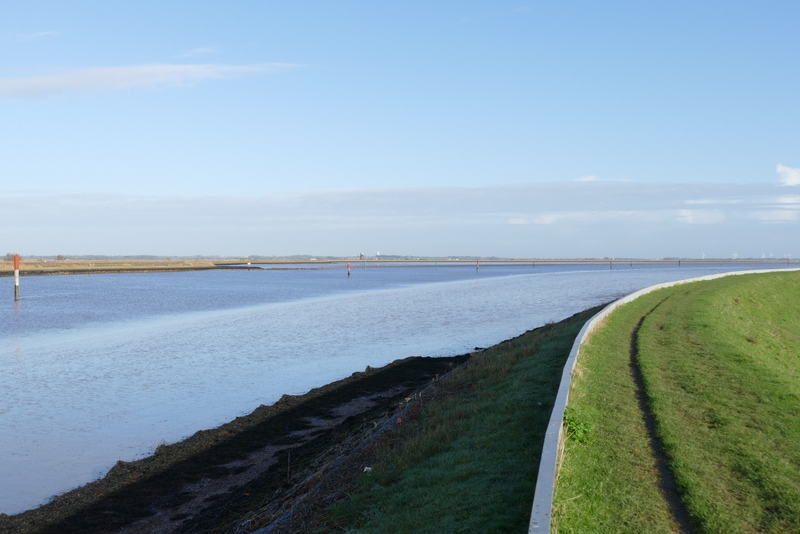 Breydon Water – looking across the estuary in the morning sun
Breydon Water – looking across the estuary in the morning sun
We walked a short way along the bank so that we could get a better view of the estuary. There were thousands of birds out on the mud – waders including lots of Golden Plover and Lapwing, and a wide variety of dabbling ducks, particularly Wigeon and Shoveler plus a few Gadwall and Pintail.
We then made our way back and climbed up the steps to Burgh Castle itself, the remains of a 3rd Century Roman fort. From the high ground here, there is a fantastic view across the low-lying marshes – all the better to scan for birds. It was truly glorious looking out from here in the sunshine.
 Burgh Castle – the view across to Berney Marshes
Burgh Castle – the view across to Berney Marshes
This is where the Rough-legged Buzzard had been seen, but unfortunately we could find no sign of it here today. There were several Common Buzzards and Kestrels perched on various gate posts scattered across the marshes, and a number of Marsh Harriers patrolling overhead. We had turned and started to make our way back to the car when a last scan revealed a smaller bird perched on one of the bushes. Putting the scope back up, we could see that it was a Merlin, before it flew off across the marshes.
We had other targets for the day, so we beat a retreat and drove on to Cantley Marshes. We particularly wanted to catch up with the Taiga Bean Geese, but they have been somewhat elusive at times this winter and there are not many here now – only two have been reported in recent weeks. We thought we would try Cantley first, but as we walked down to the gate from which we could scan across the grass there seemed to be rather fewer geese than normal present. A small group of geese were round to one side and the first two that we looked at seemed to have orange legs and bills. Putting the scope up, we confirmed our suspicions – the first geese we had found were the two Taiga Bean Geese. Result!
 Taiga Bean Goose – one of the two at Cantley this afternoon
Taiga Bean Goose – one of the two at Cantley this afternoon
There were a few Pink-footed Geese nearby and they gradually worked their way over until they were just behind the Bean Geese. It was great to see the two species side by side – the Taiga Beans were noticeably larger, longer necked and longer billed, as well as having orange not pink bill bands and legs. We had thought the Taiga Bean Geese might be harder to find, but the White-fronted Geese are normally much easier to see here. Today it was the other way round, and we couldn’t find any Whitefronts. As this was another species on the target list, we decided to head round to Buckenham Marshes for a look there.
We stopped just the other side of the railway crossing at Buckenham and scanned across the marshes. It was immediately obvious that more geese were over on this side today, with a much larger group of Pink-footed Geese here than at Cantley. The White-fronted Geese were not with them, but eventually we found them in the opposite corner – when they put their heads up we could see the white surround to their bills. The usual group of feral Barnacle Geese were also here, accompanied as usual by a Ross’s x Barnacle Goose hybrid.
We wanted to allow ourselves enough time at our final stop of the day, so we didn’t linger too long at Buckenham. Driving back towards the Cantley road, we stopped to admire a large flock of Fieldfares in a stubble field. Despite being so well-patterned, they were remarkably hard to see when they weren’t moving, melting away into the background. Only when they flew round could we see that there were loads of them there.
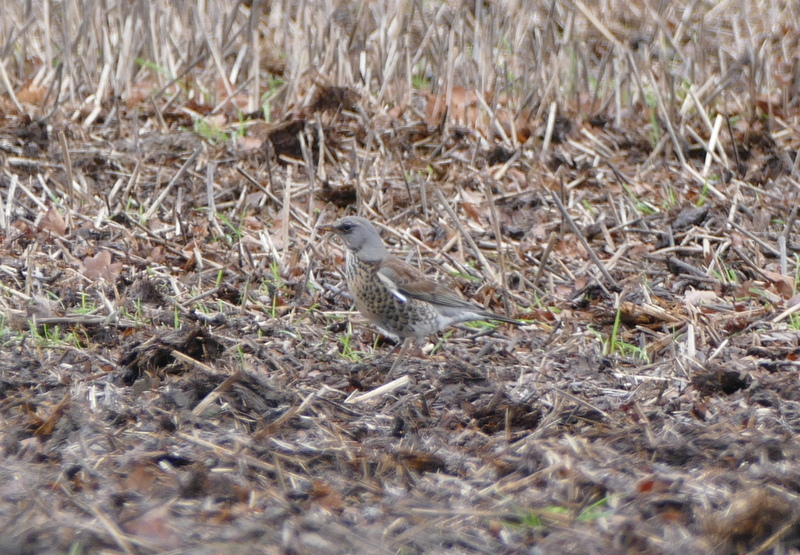 Fieldfare – we came across a huge flock in a stubble field
Fieldfare – we came across a huge flock in a stubble field
We arrived at good time back at Hickling and took the scenic route out towards Stubb Mill. A large flock of Long-tailed Tits was making its way along the hedgerow, accompanied by a Goldcrest. Several Marsh Harriers were already quartering the marshes.
We were almost at Stubb Mill when a bird appeared above the bank ahead of us, with long stiff wings beating in a distinctive rowing action – a Short-eared Owl. We only got onto it for a couple of seconds before it dropped down out of view. Thankfully, once we got round to the watchpoint, it reappeared round that side from behind the trees. We were treated to a prolonged display as it flew round and round the marshes in front of us.
 Short-eared Owl – out quartering the marshes for ages this afternoon
Short-eared Owl – out quartering the marshes for ages this afternoon
At one point, it disappeared back behind the trees and the next thing we knew we could hear a Kestrel calling loudly. The Short-eared Owl then circled up high into the sky, with the Kestrel initially in pursuit, before losing interest. We could see that the Short-eared Owl was holding something in its talons, presumably a vole. It clearly didn’t want to be robbed of its catch and after a couple of attempts it transferred the vole to its bill and promptly swallowed it whole as it circled high up into the sky. It then landed for a while in the bushes to digest – where we could get in the scope – before resuming hunting.
Even better, then a Barn Owl appeared as well and the two proceeded to hunt over the same area, in the same view at times. They seemed to ignore each other completely. In the end, we saw two different Barn Owls over the marshes in front of us, with another two further over.
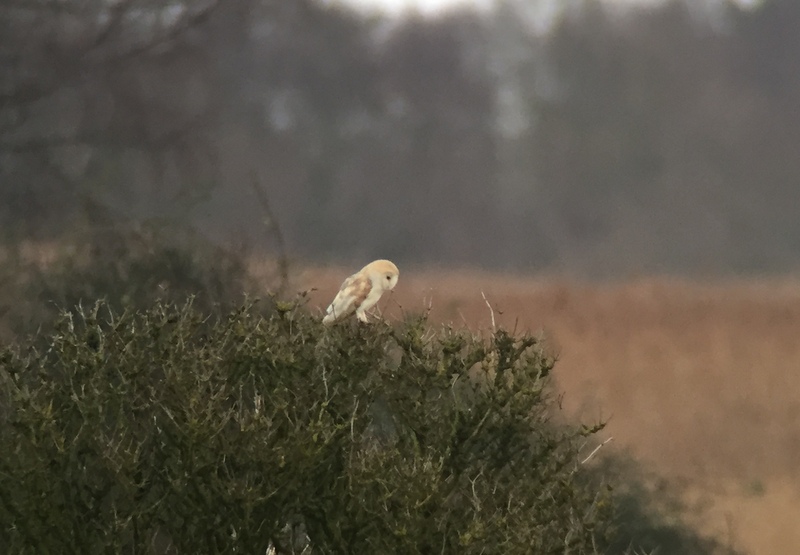 Barn Owl – one of two hunting the same field as the Short-eared Owl
Barn Owl – one of two hunting the same field as the Short-eared Owl
There were also a couple of Cranes out on the marshes in front of the watchpoint – we had heard them bugling as we walked out. They were round behind the Mill at first and harder to see, but after a while they flew round and landed at the back of the fields directly in front. Just as we had started the day, so it was nice to see another two Cranes at the close. The sound of Cranes bugling is a real treat on a winter’s evening in Broadland.
 Crane – another two this evening at Stubb Mill
Crane – another two this evening at Stubb Mill
What we had really come to see were the harriers coming in to roost. There were already a good number of Marsh Harriers out in the bushes in the reeds when we arrived, but there was a steady stream drifting in from all directions. At one point we had around 15 perched in a long line. Only when most of them took to the air could we appreciate just how many there were – 35 in view at the same time. And still they kept coming in. We estimated that there were probably 55-60 Marsh Harrier in the roost this evening.
Dusk was already descending when the first Hen Harrier appeared, making its way in towards the roost through the bushes in front of us. It was hard to pick up but we got it in the scope and you could see the white patch at the base of the tail. Then more Hen Harriers arrived in a little flurry of activity, so that it was hard to estimate how many there were, probably three ringtails (females or juveniles) and one smart grey male which ghosted across.
As the light faded, we decided to start walking back to the car park. Just as we got onto the path, a plump shape shot across over the hedge in front of us and out across the marshes – a Woodcock coming out of the woods where it had been roosting to feed out in the fields at night.
It had been a great day – with all the main target species seen which you would hope to come across on such a glorious winter’s day in the Broads.
















